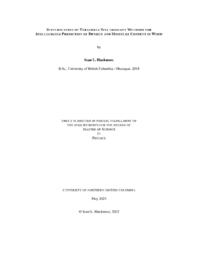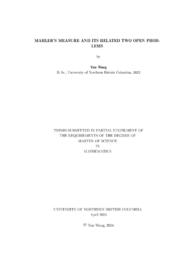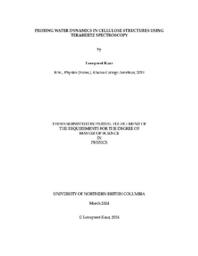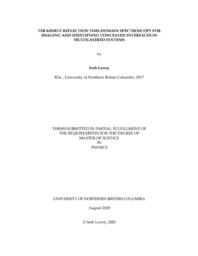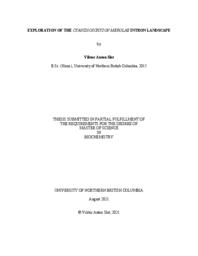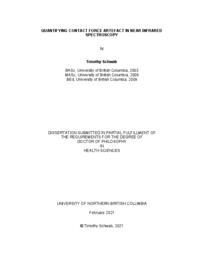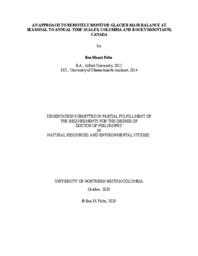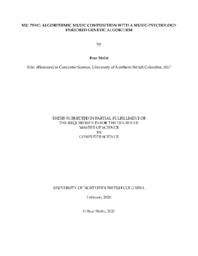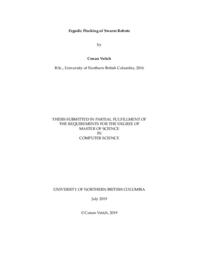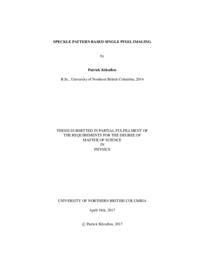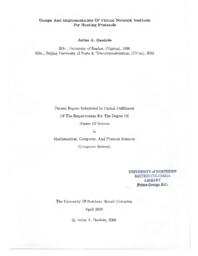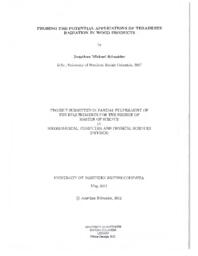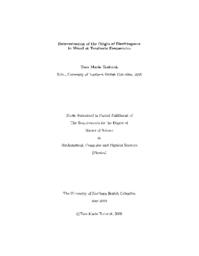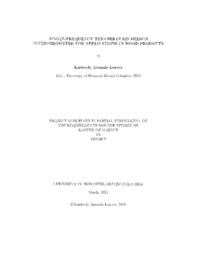Reid, Matthew
Person Preferred Name
Matthew Reid
Related Works
Content type
Digital Document
Origin Information
Content type
Digital Document
Description / Synopsis
The main achievement of the thesis is the proof that 1+√17 is not a Mahler measure of an algebraic number. This answers a question of A. Schinzel posted in [6] in 2004. We also show that, theoretically, there exists an algorithm to reduce the shortness of a polynomial without changing its Mahler measure, a problem considered in [5] by J. McKee and C. Smyth. However the number of computations required makes this algorithm infeasible.
Origin Information
Content type
Digital Document
Description / Synopsis
Terahertz time-domain spectroscopy was used to probe water dynamics in microcrystalline cellulose. In this study, the variation of the dielectric constant of water in microcrystalline cellulose samples with moisture contents between 2.65% and 16.73% was studied. It was found that the dielectric function of water does change with a change in moisture content in microcrystalline cellulose. The dielectric function of water appears to change from what might be expected for bound water towards values that are more consistent with bulk water at higher moisture content. This study is a step forward in the direction of understanding if the dielectric function of water goes from bound to free with a change in moisture content in microcrystalline cellulose. Future work to understand the detailed behavior of this transition is important for wood science and THz application to wood science.
Origin Information
Content type
Digital Document
Description / Synopsis
This thesis reviews multiple forms of terahertz spectroscopy and imaging, and exploits a combination of aspects from the techniques involved to undertake a novel method. With the use of this method, subsurface interfaces within a practical, insulated system are spatially imaged and identified. Initially, transmission spectroscopy is used to select the insulating material of the system based on favourable dielectric properties, followed by the use of dove prism reflection spectroscopy to understand and qualitatively contrast the responses of the interfaces to reflecting terahertz pulses. After constructing a reflection imaging system, multiple interface materials concealed by insulation are successfully located and identified by coloured overlays in a 100 by 100 image. Further exploration of applications involving the proposed method is also discussed.
Origin Information
Content type
Digital Document
Description / Synopsis
The eukaryotic process of pre-mRNA splicing involves the removal of noncoding intron sequences and the fusion of the remaining protein-coding exon sequences. The splicing reaction is catalyzed by the spliceosome, a dynamic multi-megadalton ribonucleoprotein complex that, in humans, is composed of 5 small nuclear RNAs (snRNAs) and over 200 associated proteins acting on more that 200,000 introns present within 25,000 genes. The unicellular red alga Cyanidioschyzon merolae possesses a more tractable splicing environment, with only 4 snRNAs and 75 associated proteins interacting with 27 annotated introns found in 26 our of 5,331 genes. Intron-rich genomes can confer benefits to their host species such as improved gene expression, incredible proteomic diversity, and increased genetic stability. This raises the question of why intron-poor C. merolae has retained such a small number of introns and a dramatically reduced spliceosome. A comprehensive investigation into the precise role that introns play in C. merolae would require the systematic removal of introns and an analysis of the effects thereof. The ability to elucidate the role of splicing in C. merolae via genome-wide intron deletion, however, hinges on the feasibility of establishing the efficiently scalable CRISPR genome engineering tool in C. merolae. It also follows that such an endeavour would require an accurate picture of the intron landscape of C. merolae, and since the number of annotated introns in C. merolae is relatively small, it is especially vital to determine whether any introns are missing from the C. merolae annotation. To that end, a stable and inducible Cas9-expressing strain of C. merolae was successfully developed. Transcriptome analysis using RNA-seq data revealed the discovery of 11 novel introns and 1 misannotated intron, as well as the presence of alternative splicing in the form of alternative splice site usage.
Origin Information
Content type
Digital Document
Description / Synopsis
Transcutaneous near infrared spectroscopy (NIRS) of muscle requires coupling between the device and the skin. An unfortunate by-product of this coupling is contact force artefact, where the amount of contact force between the device and the skin affects measurements. Contact force artefact is well known, but largely ignored in most NIRS research. We performed preliminary investigations of contact force artefact to quantify tissue behaviour to inform future NIRS designs. Specifically, we conducted three studies on contact force artefact: (i) an experimental investigation of static load at varied levels of contact force and muscle activation, (ii) an experimental investigation of oscillating load at varied levels of contact force and frequency, and (iii) a Monte Carlo simulation of photon propagation through skin, adipose tissue, and muscle. Our results confirmed that contact force artefact is a confounding factor in NIRS muscle measurements because contact force affects measured hemoglobin concentrations in a manner consistent with muscle contractions. Further, the effects of contact force are not altered by muscle contraction and a likely candidate for the mechanism responsible for contact force artefact is the viscoelastic compression of superficial tissues (skin and adipose) during loading. Simulation data suggests that adipose tissue plays a key role in diffuse reflectance of photons, so any compression of the superficial tissues will affect the reflected signal. Further research is required to fully understand the mechanisms behind contact force artefact, which will, in turn, inform future NIRS device designs.
Origin Information
Content type
Digital Document
Description / Synopsis
My dissertation investigates glacier mass change in the Columbia and Rocky Mountains of British Columbia. In chapter one I discuss the importance of the cryosphere and glaciers, introduce the climate and glaciers of the study region, and outline the objectives and structure of this dissertation. Previous work established the feasibility of geodetic methods to accurately produce winter glacier mass balance and annual glacier mass balance. These studies demonstrate that geodetic surveys can be used to estimate mass balance during the accumulation season or for one glacier over a number of years. In chapter two, I refine these published methods to measure seasonal and annual mass balance for six glaciers within two mountain ranges from 2014–2018. I use synchronous field-based glaciological measurements, airbornelaser scanningsurveys (ALS) and satelliteimagery to quantify seasonal glacier mass change from 2014–2018. Chapter three reports on radar surveys I completed of the study glaciers, adding important observations to the global database of ice thickness. I use these observations and an existing flowline model, driven with observations of surface mass balance and glacier elevation to bias-correct ice thickness estimates for each glacier. Finally, I use the model to estimate ice thickness for all glaciers in the Columbia Basin and estimate total ice volume. Chapter four builds upon previous work which used surface topography, glacier mass balance, ice thickness, and ice velocity data to estimate ice flux at discrete glacier cross-sections. Previous efforts to infer the spatial distribution of mass balance have focused on glacier tongues. I expand upon this method, calculating surface mass balance between flux gates over the entire elevation range of three glaciers, over three years. I derive the altitude-mass balance relation and demonstrate that the relation can be accurately described with high-resolution elevation and ice flux data, and suggest that this method can be expanded for large-scale estimates. Chapter five summarizes the study’s major findings, highlights its limitations and discussed its broader implications. Finally, I make recommendations that will address knowledge gaps, and improve our understanding of changing glacier conditions and ability to model glacier dynamics.
Origin Information
Content type
Digital Document
Description / Synopsis
Recent advancement of artificial intelligence (AI) techniques have impacted the field of algorithmic music composition, and that has been evidenced by live concert performances wherein the audience reportedly often could not tell whether music was composed by machine or by human. Among the various AI techniques, genetic algorithms dominate the field due to their suitability for both creativity and optimization. Many attempts have been made to incorporate rules from traditional music theory to design and automate genetic algorithms. Another popular approach is to incorporate statistical or mathematical measures of fitness. However, these rules and measures are rarely tested for their validity. This thesis is aimed at addressing the above limitation and hence paving the way to advance the field towards composing human-quality music. The basic idea is to look beyond this constrained set of traditional music rules and statistical/mathematical methods towards a more concrete foundation. We look to a field at the intersection of musicology and psychology, referred to as music-psychology. To demonstrate our proposed approach, we implemented a genetic algorithm exclusively using rules found in music-psychology. An online survey was conducted testing the quality of our algorithm’s output compositions. Moreover, algorithm performance was analyzed by experimental study. The initial results are encouraging and warrant further research. The societal implications of our work and other research in the field are also discussed.
Origin Information
Content type
Digital Document
Description / Synopsis
The design of efficient control strategies is a well studied problem. Due to recent technological advancements and applications in the field of robotics, exploring novel ways to design optimal control for multi-robot systems has gained interest. In this respect, the concept of ergodicity has successfully been applied as an effective control technique for tracking and area coverage. The generation of flocking behaviour is a problem that involves both tracking and coverage, and as such is also suited for the use of ergodicity. The main contribution of this thesis is the application of ergodicity to emulate flocking behaviour. This approach is appealing because control and communication is assumed to be local, self-organized, and does not require separate algorithms in order to generate different behaviour. Simulation results show that the proposed approach is effective and a prototype provides evidence that flocking behaviour is possible using ergodicity in a real-life setting.
Origin Information
Content type
Digital Document
Origin Information
Content type
Digital Document
Origin Information
Content type
Digital Document
Origin Information
Content type
Digital Document
Origin Information
Content type
Digital Document
Origin Information
Content type
Digital Document
Origin Information

